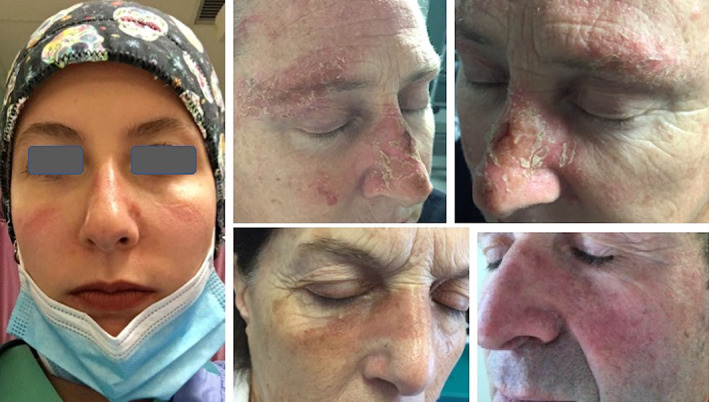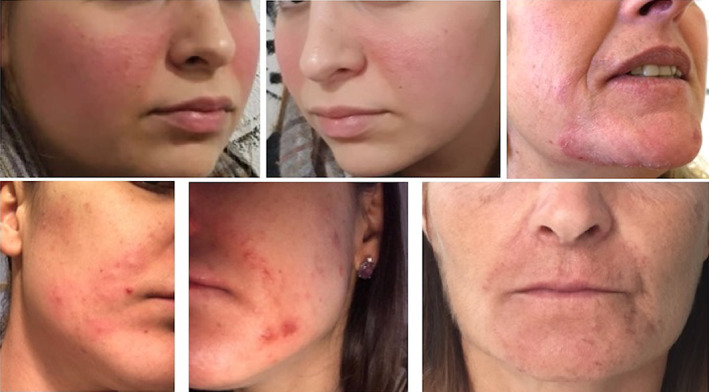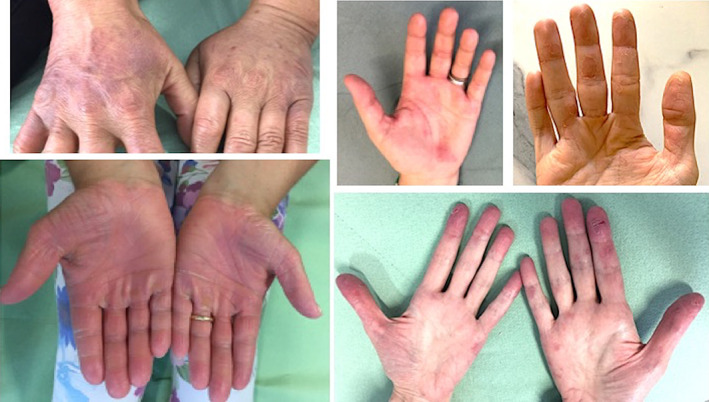Dear Editor,
The pandemic coronavirus disease 2019 (COVID‐19) has changed the approach to every patient, imposing strict preventive measures to all health care professions, beyond the management of critical patients and emergency procedures. 1 The generalized hand‐cleaning and prolonged wearing of personal protective equipment (PPE) has exponentially increased the problem of adverse skin events, which was already common in health care workers, 2 but becoming particularly relevant during previous severe acute respiratory syndrome (SARS) outbreak. 3 From the very beginning of current COVID‐19 outbreak, a Chinese study reported a prevalence of 97% of skin damage related to prevention measures among health workers. 4 Exposure duration appears as the main risk factor for face dermatitis, particularly wearing masks and goggles over 6 hours, while washing the hands more than 10 times a day could increase hands damage risk. We should also consider the additional exposure for measures application out of work. Moreover, the general population is using PPE, sometimes with less compliant devices, homemade because of the shortage of disposables. The advice on frequent hand cleaning is commonly associated with an excessive use of disinfectants, because of the great fear of the infection.
During the COVID‐19 pandemic in Italy, our Dermatology Clinic experienced an increased number of consultations for contact dermatitis, and skin injuries, requested by the colleagues and sanitary personnel of other wards, often sending images by smart phones applications to avoid visits in presence. The most affected sites included the nasal bridge, hands, cheek, periocular, and perioral regions (Figures 1, 2, 3). Dryness, itching, but also stinging sensations were common. Although majority of PPE related manifestations were mild, self‐healing when the use was stopped for sufficient time, rest and recovery was not always viable in current situation. The critical point is that adherence to strict PPE protocol is paramount, and presence of even mild abrasion, itching, or burning sensation might induce inadvertent protocol breaches, 5 such as mask touching and PPE adjustment. Perfect adherence and positioning of the PPE, especially on the face, affects its effectiveness, as well as inappropriate removal of the PPE, touching the mask or other potentially contaminated surfaces. 6 If the skin or mucous are damaged, contamination might be easier, arbor the virus and drive the viral transmission, touching the face while not wearing the PPE. 7 If incorrect behavior can occur in expert health care personnel who works with critical patients, we can imagine how easy is to make mistakes during routine health care or out of work. Prompt dermatologist referral, and management of even mild dermatitis is advisable to rapidly relieve inflammation and symptoms, so to avoid any risk of incorrect behavior and PPE misuse. Treatment is a challenging issue, the main skincare recommendations coming from a recent Chinese consensus. 8 For mild face dermatitis, we prescribed the application of moisturizers on intact skin and topical antibiotic ointment, mainly fusidic acid on super‐infected skin. For sustained contact dermatitis, low‐ to medium‐potency not fluorinated topical glucocorticoids were allowed. Hand and sometimes feet maceration were relieved with normal saline hydropathic compress and topical use of zinc oxide ointment. When erosion and exudation occurred, the application of topical glucocorticoid cream was added. Sustained dermatosis, worsening of preexisting diseases such as psoriasis or atopic dermatitis or allergic reactions might require more complex assessment and management, including the temporary removal from work for health care personnel.
FIGURE 1.

Contact dermatitis after personal protective equipment use on the face: pressure erythema on the nose and zygomatic regions; eczematous lesions in a more severe case
FIGURE 2.

Contact dermatitis after personal protective equipment use on the lower face: pressure erythema and acneiform eruptions
FIGURE 3.

Hands contact dermatitis after personal protective equipment use: prevalent dorsal involvement in one patient and pulpitis, localized, and more diffuse palmar dermatitis in other patients
As dermatologists, we are on the best position to adequately manage this outbreak of contact dermatitis, but large studies to implement PPE safety in the long‐term use, as well as indicating prophylactic and treatment measures to minimize adverse events are warranted.
CONFLICT OF INTEREST
The authors have no conflicts of interest to disclose.
ACKNOWLEDGMENTS
We are grateful to all our colleagues and health care workers, who collaborated with us, and gave permission to the publication of their cases details, and images. We are indebted to Mark Weathon for the English text revision.
All authors contributed equally to the article and had the opportunity to revise and approve the final text.
REFERENCES
- 1. WHO . Infection prevention and control during health care when COVID‐19 is suspected. Interim Guidance. March 19, 2020. https://www.who.int/publications‐detail/infection‐prevention‐and‐control‐during‐health‐care‐when‐novel‐coronavirus‐(ncov)‐infection‐is‐suspected‐20200125.
- 2. Hamnerius N, Svedman C, Bergendorff O, Björk J, Bruze M, Pontén A. Wet work exposure and hand eczema among healthcare workers: a cross‐sectional study. Br J Dermatol. 2018;178:452‐461. [DOI] [PubMed] [Google Scholar]
- 3. Foo CC, Goon AT, Leow YH, Goh CL. Adverse skin reactions to personal protective equipment against severe acute respiratory syndrome—a descriptive study in Singapore. Contact Dermatitis. 2006;55:291‐294. [DOI] [PMC free article] [PubMed] [Google Scholar]
- 4. Lan J, Song Z, Miao X, et al. Skin damage among healthcare workers managing coronavirus disease‐2019. J Am Acad Dermatol. 2020;82:1215‐1216. [DOI] [PMC free article] [PubMed] [Google Scholar]
- 5. Kantor J. Behavioral considerations and impact on personal protective equipment (PPE) use: early lessons from the coronavirus (COVID‐19) outbreak. J Am Acad Dermatol. 2020;82:1087‐1088. [DOI] [PMC free article] [PubMed] [Google Scholar]
- 6. Phan LT, Maita D, Mortiz DC, et al. Personal protective equipment doffing practices of healthcare workers. J Occup Environ Hyg. 2019;16:575‐578. [DOI] [PMC free article] [PubMed] [Google Scholar]
- 7. Bertsch RA. Avoiding upper respiratory tract infections by not touching the face. Arch Intern Med. 2010;170:833‐834. [DOI] [PubMed] [Google Scholar]
- 8. Yan Y, Chen H, Chen L, et al. Consensus of Chinese experts on protection of skin and mucous membrane barrier for health‐care workers fighting against coronavirus disease 2019. Dermatol Ther. 2020;33(4):e13310. 10.1111/dth.13310. [DOI] [PMC free article] [PubMed] [Google Scholar]


